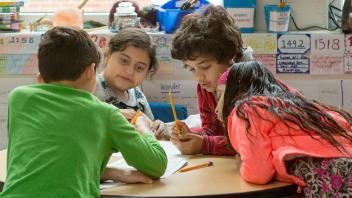

Reciprocal teaching is a cooperative learning strategy that aims to improve students’ reading comprehension skills, with four components: predicting, clarifying, questioning, and summarizing. A group of students take turns acting as the teacher in guiding the comprehension of a text.
Reciprocal teaching is a cooperative learning strategy that aims to improve students’ reading comprehension skills. A group of students take turns acting as the teacher in guiding the comprehension of a text. The strategy was developed by Annemarie Palincsar and Ann L. Brown in the 1980s.
Reciprocal teaching typically involves four main strategies or activities:
Predicting: Students make predictions about what they think will happen in the text based on prior knowledge and information from the text.
Clarifying: Students ask for clarification about parts of the text that are confusing to them. This can involve questioning unclear vocabulary, concepts, or statements.
Questioning: Students generate questions about the content of the text. These questions can be about specific details, main ideas, or inferences.
Summarizing: Students summarize the main ideas of the text in their own words. This helps reinforce understanding and identify key information.
The unique aspect of reciprocal teaching is that students take turns leading the group discussions using these four strategies. The teacher’s role is to model the process initially and then gradually hand over the responsibility to the students. The reciprocal nature of the strategy promotes collaboration, active engagement, and metacognition (thinking about one’s own thinking).
Before reciprocal teaching can be used successfully by your students, they need to learn about and practice the four strategies that are used in reciprocal teaching — predicting, clarifying, questioning, and summarizing.
(from Donna Dyer of the North West Regional Education Service Agency in North Carolina)
At Frank Love Elementary School, reading expert Shira Lubliner uses reciprocal teaching to guide students in learning to lead a classroom discussion. But first, Ms. Lubliner shows them how to guide a conversation about a book.
TranscriptOkay. Could I have group one please come up to the table.
At Frank Love Elementary school reading expert Shira Lubliner shows off a technique called reciprocal teaching that’s designed to improve reading comprehension.
Tap, tap. Tap, tap. A sea otter lies on her back in the water.
The goal of reciprocal teaching is to prepare students to run their own discussion, taking turns as leaders. But first, Ms. Lubliner shows them how to guide a conversation about a book.
See, my first job is to ask a question, and I’m going to try and ask an important main idea question that starts with a question word. Let’s see. What does the sea otter do to prepare lunch?
Dr. Louisa Moats:
There is no replacement for a teacher who can generate a good discussion and get kids to really ponder what they’ve read in the whys and wherefores and connect those meanings to their own lives.
Well, I’m going to predict that we’re going to learn some more about what sea otters eat.
Now it’s time for the kids to lead their own discussion with a little help from Ms. Lubliner.
A sign of danger.
The kids begin with a first of four clear steps: asking a question …
What do sea otters have to be careful of?
The next step is clarifying the meaning of unfamiliar words.
It means somebody likes something better than they like something else.
Afloat means a little bit above the water and they’re floating on the water, not just under it or over.
It. The next phase of reciprocal teaching is summarizing, finding the main idea.
Sea otters have a lot of enemies, so they have to be careful of eagles, white, I mean sharks, and fishermen.
The final step is prediction.
I predict that we’re learn more about otters. In this story.
Reciprocal teaching promotes a give and take between teachers and students that achieves the ultimate purpose of reading. Finding the meaning,
Major funding for Reading Rockets comes from the United States Department of Education, office of Special Education Programs. For author interviews, recommended reading lists, and information about teaching kids to read, please visit us online at www.ReadingRockets.org.
Oczuks, L. (2003). Reciprocal teaching at work: Strategies for improving reading comprehension. Newark, DE: International Reading Association.
Palincsar, A. S. & Brown, A. (1984). Reciprocal Teaching of Comprehension-Fostering and Comprehension Monitoring Activities. Cognition and Instruction, 1(2), pp. 117-175.